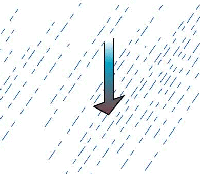 Nearly 80% of the air we breathe is nitrogen gas (N2), and is only directly usable as a biological nitrogen source by a certain group of bacteria. Atmospheric N2 is converted to nitrate (NO3-), a biologically important form, by lightning. Volatile organic nitrogen compounds are released to the atmosphere during plant decay. Industrial emissions and fossil fuel combustion contribute gaseous nitrous oxides and nitrate as nitric acid (one component of "acid rain") from sources sometimes hundreds of miles distant. Atmospheric nitrogen is delivered to sea and land in rainfall as dissolved compounds ("wet" deposition) and as adsorbed compounds on dust particles and leaves ("dry" deposition). Dry deposition, or air pollution, contributes large amounts of nitrogen to watersheds. In some areas the amount of nitrogen in dry deposition is as large as that in wet deposition or precipitation. Coastal fogs are another source of nitrogen. Where the
Nearly 80% of the air we breathe is nitrogen gas (N2), and is only directly usable as a biological nitrogen source by a certain group of bacteria. Atmospheric N2 is converted to nitrate (NO3-), a biologically important form, by lightning. Volatile organic nitrogen compounds are released to the atmosphere during plant decay. Industrial emissions and fossil fuel combustion contribute gaseous nitrous oxides and nitrate as nitric acid (one component of "acid rain") from sources sometimes hundreds of miles distant. Atmospheric nitrogen is delivered to sea and land in rainfall as dissolved compounds ("wet" deposition) and as adsorbed compounds on dust particles and leaves ("dry" deposition). Dry deposition, or air pollution, contributes large amounts of nitrogen to watersheds. In some areas the amount of nitrogen in dry deposition is as large as that in wet deposition or precipitation. Coastal fogs are another source of nitrogen. Where the
 Nearly 80% of the air we breathe is nitrogen gas (N2), and is only directly usable as a biological nitrogen source by a certain group of bacteria. Atmospheric N2 is converted to nitrate (NO3-), a biologically important form, by lightning. Volatile organic nitrogen compounds are released to the atmosphere during plant decay. Industrial emissions and fossil fuel combustion contribute gaseous nitrous oxides and nitrate as nitric acid (one component of "acid rain") from sources sometimes hundreds of miles distant. Atmospheric nitrogen is delivered to sea and land in rainfall as dissolved compounds ("wet" deposition) and as adsorbed compounds on dust particles and leaves ("dry" deposition). Dry deposition, or air pollution, contributes large amounts of nitrogen to watersheds. In some areas the amount of nitrogen in dry deposition is as large as that in wet deposition or precipitation. Coastal fogs are another source of nitrogen. Where the
Nearly 80% of the air we breathe is nitrogen gas (N2), and is only directly usable as a biological nitrogen source by a certain group of bacteria. Atmospheric N2 is converted to nitrate (NO3-), a biologically important form, by lightning. Volatile organic nitrogen compounds are released to the atmosphere during plant decay. Industrial emissions and fossil fuel combustion contribute gaseous nitrous oxides and nitrate as nitric acid (one component of "acid rain") from sources sometimes hundreds of miles distant. Atmospheric nitrogen is delivered to sea and land in rainfall as dissolved compounds ("wet" deposition) and as adsorbed compounds on dust particles and leaves ("dry" deposition). Dry deposition, or air pollution, contributes large amounts of nitrogen to watersheds. In some areas the amount of nitrogen in dry deposition is as large as that in wet deposition or precipitation. Coastal fogs are another source of nitrogen. Where the